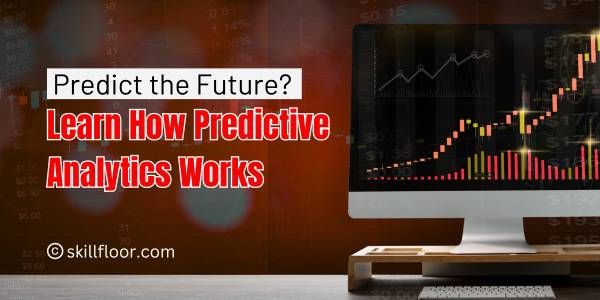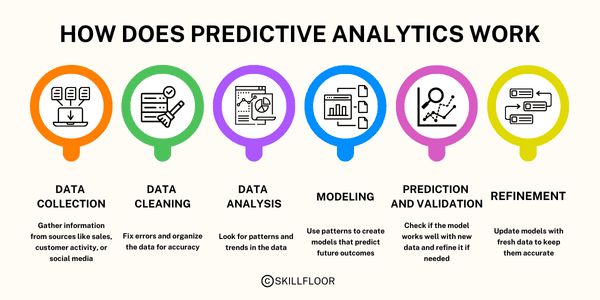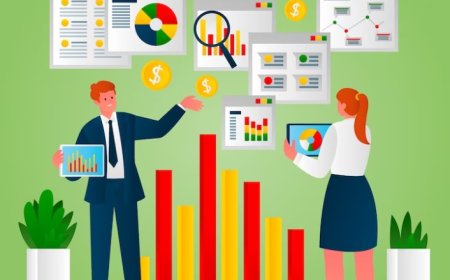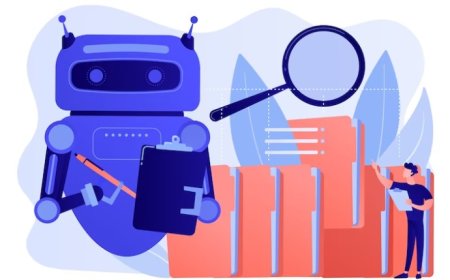What is Predictive Analytics? How does it work
Learn about predictive analytics: how it predicts trends, helps companies make smart decisions, reduces risks, and grows fast. Don’t miss out—learn now!

Have you ever wondered how businesses seem to know what customers want before they even ask? Or how they can predict trends and make decisions that seem incredibly accurate? The secret behind this is Predictive Analytics. As a data analyst, I have seen how powerful this tool can be in helping organizations forecast future outcomes based on past data. It's not about just looking at what's happened; it's about predicting what's going to happen next and using that information to make smarter decisions.
Predictive Analytics works by analyzing patterns in historical data and applying statistical algorithms and machine learning techniques to anticipate future trends. With the right data, you can forecast everything from customer behavior to market shifts, helping you stay one step ahead. Let’s explore how Predictive Analytics works and why it's becoming an essential tool for anyone looking to make data-driven decisions.
What is Predictive Analytics?
Predictive Analytics is a branch of data analytics that uses historical data, statistical algorithms, and machine learning techniques to predict future outcomes. Unlike traditional analytics, which helps us understand past events, Predictive Analytics allows us to forecast what might happen in the future. This is incredibly useful for businesses that want to improve decision-making, optimize strategies, and identify risks ahead of time.
For example of predictive analytics, an e-commerce company might use Predictive Analytics to forecast which products are likely to sell best during the upcoming season, based on past sales data and current market trends. Similarly, a bank can predict whether a customer might default on a loan based on their past financial behavior and other risk factors. Predictive Analytics can be applied to a wide range of fields, from customer behavior forecasting to supply chain management, helping businesses gain a competitive edge.
How Does Predictive Analytics Work?
The core of Predictive Analytics is turning historical data into actionable insights that can guide future decisions. Here’s a breakdown of how it works:

-
Data Collection: The first step is gathering the relevant data. This data can come from various sources, including customer behavior, sales transactions, weather patterns, or social media activity. The more data you have, the better your predictions will be. For instance, an online store may collect data on past customer purchases, demographics, browsing behavior, and seasonal trends.
-
Data Cleaning: Raw data is often messy, with errors, missing values, or inconsistencies. To make sure the analysis is accurate, data needs to be cleaned and organized. This step involves removing duplicate entries, handling missing values, and ensuring that all the data is in a consistent format. Clean data is essential for building accurate predictive models.
-
Data Analysis: Once the data is cleaned, it is analyzed using various statistical and mathematical techniques. The goal is to find patterns, trends, and relationships between different variables. For example, if you're predicting future sales, you might analyze factors like previous sales figures, marketing campaigns, and customer preferences to find patterns that indicate future sales trends.
-
Modeling: The next step is to build a predictive model. A model is a mathematical representation of the data that helps make predictions. Predictive models can be built using various techniques such as regression (for predicting continuous outcomes), classification (for predicting categories), or clustering (for grouping similar data). These models use the patterns identified during the analysis phase to predict future outcomes.
-
Prediction and Validation: After building the model, it’s time to test it. New data is fed into the model to see how well it can predict outcomes. This process helps determine if the model is accurate and reliable. If the predictions are not as expected, the model may need to be refined or adjusted. Over time, the model can become more accurate as more data is used to train it.
-
Refinement: Predictive models are not static. As new data is collected, the models are updated and refined. This ensures that the predictions remain accurate and relevant over time. For example, if a retailer’s sales patterns change due to seasonality, the model can be updated to reflect these changes and improve its forecasts.
The Role of Data in Predictive Analytics
Data is the foundation of Predictive Analytics. Without data, there would be no predictions. The quality, quantity, and relevance of the data are crucial to making accurate forecasts.
There are two main types of data used in Predictive Analytics:
-
Structured Data: This is data that is organized in a clear, tabular format, making it easy to analyze. Examples include customer names, sales numbers, or product prices. Structured data is easy to work with because it fits neatly into spreadsheets or databases.
-
Unstructured Data: This type of data doesn’t fit into a tidy table or database. It includes things like emails, social media posts, text reviews, images, and videos. Analyzing unstructured data requires more sophisticated techniques like Natural Language Processing (NLP) for text or image recognition for pictures.
Data must also be clean for accurate predictions. This means removing errors, filling in missing information, and ensuring consistency across the data set. Data cleaning is often one of the most time-consuming steps in the process but is essential to building effective predictive models.
Predictive Analytics Models
A predictive model is essentially a set of mathematical equations that helps predict future outcomes based on past data. There are several types of predictive models, each suited for different purposes:
-
Classification Models: These models are used to predict a category or class. For example, a classification model can predict whether a customer will buy a product (yes/no) or whether an email is spam or not. It assigns each observation to a specific class based on the data.
-
Regression Models: These models are used when you need to predict a continuous outcome. For example, predicting sales revenue, house prices, or the temperature. Regression models estimate the relationship between dependent variables (e.g., sales) and independent variables (e.g., seasonality, promotions).
-
Clustering Models: These models group data into clusters based on similarities. For example, clustering can help identify customer segments with similar purchasing behavior. This is valuable for targeted marketing or customizing offerings for different customer groups.
|
Model Type |
Description |
Examples of Use Cases |
|
Classification Models |
Predicts a category or class for each observation based on the data. |
|
|
Regression Models |
Predicts a continuous outcome by estimating relationships between variables. |
|
|
Clustering Models |
Groups data into clusters based on similarities to identify patterns or segments. |
|
Each model uses historical data to identify patterns, and then uses these patterns to predict what is likely to happen next.
Predictive analytics techniques and tools Used
Predictive Analytics involves a range of tools and software that help build, refine, and deploy predictive models. Some of the most widely used tools for predictive analytics include:
-
Python: Python is a programming language widely used in data science. It has several libraries designed for data analysis and machine learning, such as Pandas for data manipulation, Scikit-learn for building machine learning models, and TensorFlow for deep learning applications.
-
R: R is another powerful language for statistical analysis and data visualization. It is particularly popular for creating advanced statistical models and conducting detailed data analysis.
-
SAS: SAS is a software suite for data management, advanced analytics, and Predictive Analytics. It’s widely used in industries like finance, healthcare, and marketing to build and deploy predictive models.
-
Microsoft Azure Machine Learning: Azure is a cloud-based platform that provides tools and services for building, training, and deploying machine learning models. It is especially useful for businesses that need to scale their Predictive Analytics efforts without managing infrastructure.
These Predictive analytics tools help automate and speed up the process of creating predictive models and making predictions. In addition, data visualization tools such as Tableau and Power BI are used to present data insights in visual formats, which makes it easier for decision-makers to understand and act on the predictions.
Applications of Predictive Analytics
Predictive Analytics is being used across many industries to help solve a variety of problems and improve decision-making:
-
Healthcare: Predictive analytics in healthcare is used to predict patient outcomes, detect early signs of diseases, and optimize hospital resources. For example, hospitals can predict which patients are at high risk of readmission, allowing them to provide targeted care to reduce readmission rates.
-
Retail: Retailers use Predictive Analytics to forecast demand, manage inventory, and offer personalized recommendations to customers. Predictive models help retailers optimize their supply chains by predicting which products will be in high demand during specific seasons or sales events.
-
Finance: In the finance sector, Predictive Analytics is used to assess credit risk, detect fraud, and forecast market trends. Financial institutions can predict whether a loan applicant is likely to default, or use predictive models to identify unusual transactions that may indicate fraud.
-
Manufacturing: Predictive Analytics helps manufacturers predict when equipment will fail or need maintenance, reducing downtime and lowering repair costs. By anticipating failures, businesses can schedule maintenance before a breakdown occurs, ensuring smoother operations.
Benefits of Predictive Analytics
Predictive Analytics offers several key benefits:
-
Better Decision Making: By relying on data-driven insights, businesses can make better-informed decisions that are more likely to succeed.
-
Cost Savings: Predicting problems before they occur helps businesses avoid costly mistakes, such as unanticipated equipment breakdowns or inventory shortages.
-
Personalization: Predictive Analytics helps businesses offer personalized experiences to customers. For example, e-commerce websites can suggest products that a customer is likely to buy based on their past behavior, improving customer satisfaction.
-
Efficiency: By optimizing resources based on forecasts, businesses can become more efficient. Predictive Analytics helps streamline operations and ensure that businesses are using their resources in the most effective way.
Challenges in Predictive Analytics
Although Predictive Analytics offers many benefits, it also comes with challenges:
-
Data Privacy: Collecting and using personal data for predictive modeling can raise concerns about privacy and data security. Companies must follow legal regulations, like GDPR, to ensure that data is handled responsibly.
-
Model Complexity: Predictive models can be complex, and sometimes they can overfit the data (i.e., they are too closely tailored to historical data, which makes them less reliable for new data). It’s important to strike the right balance when building models.
-
Data Availability: Having enough data is key to building accurate models. In some cases, businesses may not have sufficient historical data to make accurate predictions.
Future of Predictive Analytics
As technology continues to advance, the field of Predictive Analytics will continue to evolve:
-
AutoML: Automated Machine Learning (AutoML) will make it easier for people with little technical knowledge to create machine learning models, democratizing access to predictive tools.
-
Real-Time Predictions: With faster computing power and improved data collection methods, businesses will be able to make real-time predictions. For example, stock traders will use real-time analytics to react quickly to changes in the market.
-
Ethical AI: As Predictive Analytics becomes more widespread, there will be an increasing focus on making sure the models are fair and free from bias. Ethical AI will ensure that these tools are used responsibly.
Predictive Analytics is a powerful tool that helps businesses and organizations forecast future outcomes based on historical data and patterns. By using statistical algorithms and machine learning models, it allows decision-makers to anticipate trends, identify risks, and make more informed choices. Whether it's predicting customer behavior, optimizing operations, or preventing potential issues, Predictive Analytics enables organizations to stay ahead of the curve and make smarter, data-driven decisions. It's an essential tool that can improve efficiency, save costs, and enhance overall performance across various industries.






























































